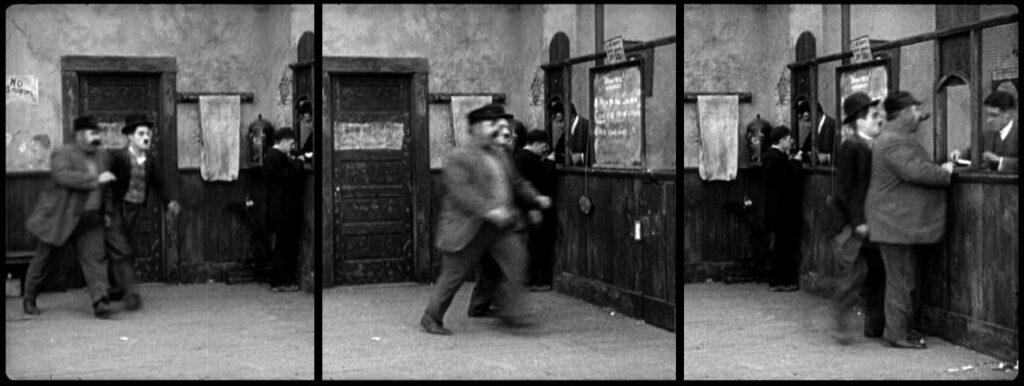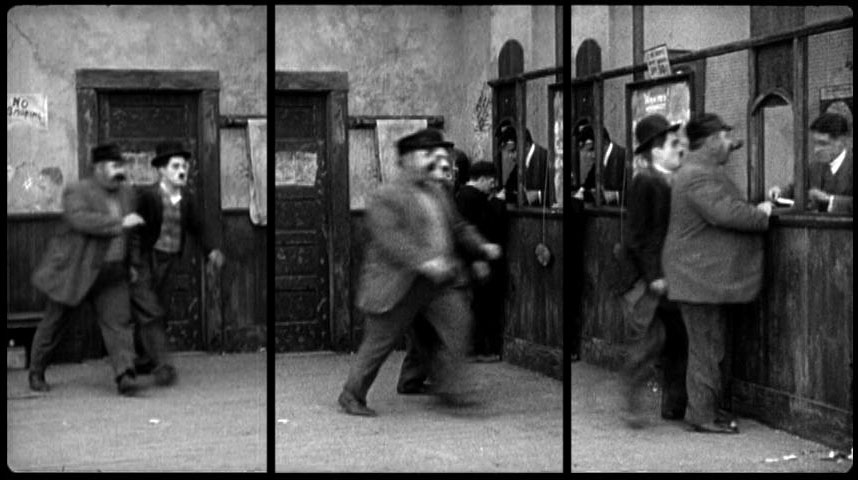There was something slightly unsettling about the employment office sequence I saw in the “The Chaplin Revue” (1959) of “A Dog’s Life”. It wasn’t just that it felt like it was running too slow. An easy call to make but difficult to explain. I wanted to know what the explanation was. Years after seeing this in a revival house I figured out why it seemed to be running slower than it should be.
(BTW, I’d dropped the ball on this thread back in May, and am picking it back up now. If you want to read the post that sets this post up, read it here…but do come back.)
I got my hands on a DVD of The Chaplin Revue and took a look at the sequence in question, the one where Chaplin kept going up to the window and everyone else kept getting in front of him. I vaguely remember that I’d somehow ripped the file and brought into iMovie (that’s how long ago this was), and sped the footage up a little.
And…bingo.
Not only did the sequence “look right”, but two things were now in place. The business was funny, and I was now seeing the Charlie Chaplin I knew. Rather than seemingly and stupidly letting each of the other men slip in front of him over and over, what I now saw was the Little Tramp earnestly walking briskly to the window and each time someone zipped in front of him at the last instant and snagging the job offered at the window. This was then capped by the clown business of his being caught up in the routine of dashing back and forth, repeating the action even after there were no jobs left and no more men running up to the window.
How did this happen? How was this suddenly a Charlie Chaplin physical comedy routine where moments before it, well…wasn’t.

This was my big light-bulb-over-the-head moment, when I realized that silent film wasn’t just the slightly-faster projection speed, but that it was a combination — really a collaboration — of performance and that speed-up. Of knowing the film would be shown faster in theaters and utilizing the speed-up by moving or creating movement at a different and specific pace for it.
The very reason that Silent Film does not look merely look the way film does when it’s run faster. More on this, in my next post…
The first post in this series is here.
The previous post (#45) to this one is here.
The next post (#47) to this one is here.

Read all your posts, and it certainly helps increase my knowledge of the various aspects of silent film. This particular blog explains some things I have always wondered about, as far as pacing and film speed is concerned. Thanks for the education!
You’re welcome. There’s more on the way!
Spot on, Ben, as always. As a youngster who came of age watching the Mutuals at 24fps (and with Van Beuren scores), I long wondered what happened to Charlie in 1918. Did the strain of independent production suddenly make him unfunny? It is truly a shame that late 1950s Charlie bought into the notion of “modernizing” his films by slowing the motion to “natural” speed.
The Mutuals were never shown or meant to be shown at 24fps; they were typically shown at 20 or 21 fps. What’s remarkable about them is that they hold up better at 24 fps than most comedy shorts from 1916-1917.
What happened to Chaplin in 1918? My strong feeling is that the untimely death of Eric Campbell late in 1917 was a great loss, creatively. Campbell was an ideal adversary for Charlie’s “little fellow” and it took him a while to find a new adversary. Imaging the Fleischers dropping Bluto in 1932 and what would have happened to Popeye cartoons.